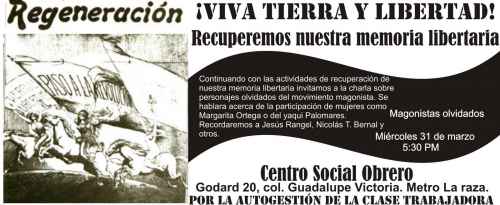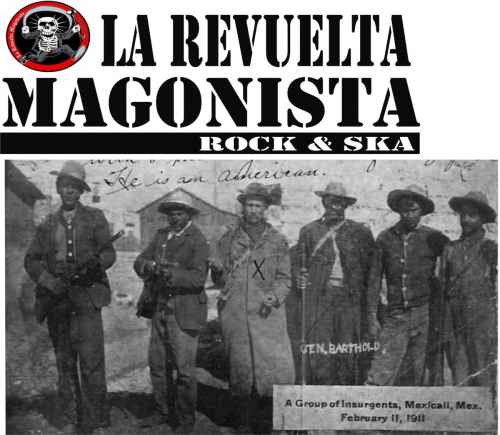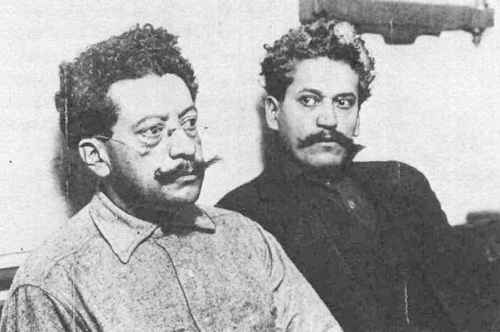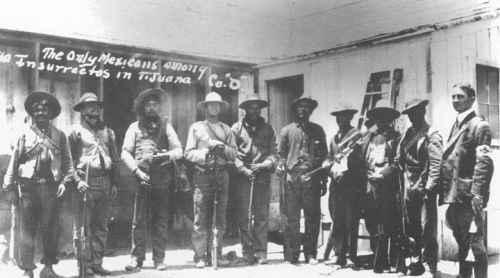Land and Liberty
On January 29, 1911, a small band of 18 revolutionaries marched into Mexicali and seized the town, practically without firing a shot. Thus began one of the most unusual and controversial episodes in Mexican history.
These revolutionaries were not the typical warlords that Mexico was used to seeing. These revolutionaries had American volunteers, but not the sort of filibusters that Baja California was already very familiar with. In fact, this revolutionary movement had little in common with anything Mexico had experienced before or since.

These revolutionaries weren't interested in just overthrowing the corrupt and repressive government, they wanted to overthrow society as well.
Ricardo Flores Magón was born on Mexican Independence Day in 1874. Ricardo and his brothers, Jesús and Enrique, grew up in extreme poverty.
Early on, Flores embraced the anti-clerical, reform agenda of the liberal society. On August 7, 1900, Flores, his brothers, and Antonio Horcasitas founded the periodical Regeneración. The very next year Flores would help found the Partido Liberal Mexicano (i.e. Mexican Liberal Party). This journalistic/political alliance would become one of the origins upon which the Mexican Revolution was founded.
"The Liberal Party works for the welfare of the poor classes of the Mexican people. It does not impose a candidate (in the presidential election), because it will be up to the will of the people to settle the question. Does the people want a master? Well let them elect one. All the Liberal Party desires is to effect a change in the mind of the toiling people so that every man and woman should know that no one has the right to exploit anybody."
- Flores Magon, November 20th 1910

Ricardo Flores was an anarchist. He was influenced by the early anarchist writings of Mikhail Bakunin and Pierre-Joseph Proudhon, but his primary influence was Peter Kropotkin. It is with this philosophy that the Liberal Party would be built upon.
The Magonistas were campesinos, industrial workers, miners, and a smattering of middle-class intellectuals. Their original aim was to bring down the dictatorship of Porfirio Diaz. They used strikes, propaganda, and even guerrilla tactics of sabotage to undermine the government. Before long they were wanted men. On January 4, 1904, Flores Magón, his brother Enrique, and a few supporters, fled crossed the border into Texas.
The Magonista leadership remained in exile from 1904 to 1907, where they continued to print the Regeneracion, which eventually reached a circulation of 27,000 despite the targeted readership being largely illiterate.
On July 1, 1906, the Magonistas published a call for revolution. Liberal groups organized overwhelmingly by the PLM began a series of direct attacks on the state-capitalist system in Jimenez, Coahuila, Camargo, Tamaulipas, Acayucan and other cities. The attacks failed miserably due to lack of funds, weapons, and recruits.
What the Magonistas failed to anticipate was that they had other enemies besides just Diaz. The revolts caught the attention of a capitalist land-owner in Los Angeles by the name of Harrison Gray Otis, the owner of the Los Angeles Times. Together with industrialist William Greene, Otis spent thousands of dollars of his own money hiring the Furlong Detective Agency to round up Magonista leadership within America by the hundreds, starting in August 1907. They weren't charged with crimes against any living thing, but instead were tried for spreading revolutionary propaganda.
The Magonistas tried another revolt in 1908, which failed for similar reasons. By 1910 the PLM was nearly bankrupt. This caused the PLM to change its focus to primarily Baja California, and to rely on support from socialist and labor groups in America, with the Industrial Workers of the World (i.e. Wobblies) taking the lead.
It was around this time that Francisco Madero began the much more widely supported and better funded Mexican Revolution. With the Diaz government shaken from a nationwide revolution, the PLM decided to make their move in Mexicali.
"Governments have to protect the right of property above all other rights. Do not expect then, that Madero will attack the right of property in favour of the working class. Open your eyes."
- Flores Magon, November 1910
By January 1911 the PLM was successfully liberating towns and villages in six different Mexican states. In March, a peasant army led by Emilio Zapata, but influenced by Magon, rose in revolt.
Within three days of the Magonistas seizing Mexicali, 120 volunteers flocked to the cause, 40 of them were anglo Wobblies from America. The Wobblies had been instrumental for months now in smuggling arms across the border, and for raising money for the cause. Wobblie members of note were Joe Hill and Frank Little.
"We socialists, anarchists, hoboes, chicken thieves, outlaws and undesirable citizens of the U.S. are with you heart and soul. You will notice that we are not respectable. Neither are you. No revolutionary can possibly be respectable in these days of the reign of property...I for one wish there were more outlaws of the sort that formed the gallant band that took Mexicali."
- Jack London, February 5, 1911
After building up their numbers and resources, the Magonistas then marched on Tecate, capturing small mining towns along the way. On March 12, Tecate fell to the rebels, but the federal soldiers were beginning to organize and offer tougher resistance. Colonel Celso Vega, governor of the region, sent a force of 100 to defeat the revolutionaries. Through a combination of desertions and poor logistics, the federal army was soundly defeated by the Magonistas. The way was now open to the Pacific.
Meanwhile, on February 8, a force of Magonistas seized Guadalupe, Chihuahua, capturing weapons and supplies in the process. Another force of 200 captured the towns of Sasabe, Hermisillo, Arizpe, and Bacoachi. However, this force was defeated in March and its leaders were executed.
In response to the unrest, the American government sent 20,000 troops to the border in order to cut off the source of supplies and weapons. Recruits for the rebellion were sought openly in I.W.W. halls, offering $1 a day and 160 acres of land.

"The Mexican Liberal Party is not fighting to destroy the dictator Porfirio Diaz in order to put in his place a new tyrant. The PLM is taking part in the actual insurrection with the deliberate and firm purpose of expropriating the land and the means of production and handing them over to the people, that is, each and every one of the inhabitants of Mexico without distinction of sex. This act we consider essential to open the gates for the effective emancipation of the Mexican people."
- PLM manifesto, April 1911
By this time the Magonista army in Baja numbered about 300, 100 of which were Wobblies. At dawn on May 10, the long anticipated attack on Tijuana began. By 8 a.m. it was all over. Around 20 of the Federal defenders and a dozen of the rebels had been killed. A large red flag was raised over the tiny town with the slogan "Tierra y Libertad" on it.
It was at this point, when the Magonistas seemed to have everything going for them, that it all began to fall apart.

The biggest problem was that Madero and Diaz had signed a peace agreement on the condition of Diaz stepping down as dictator. With the revolution temporarily suspended, the federal forces were now free to turn on the Magonistas. An army of nearly 600 was being organized at Ensenada.
It's possible that this threat could have been dealt with except for four other crippling issues:
- supplies were getting exhausted because of the military blockade at the border. This included everything from ammunition to food.
- a general lack of leadership. Much of the Magonista leadership had been arrested, and those that remained were politicians, not generals. Magon himself never left California to directly participate in the revolt.
- the revolution had been infiltrated by opportunists. A number of profiteers sold "day-passes" to San Diego tourists who freely looted Tijuana shops.
- a general lack of support from the local population.
On June 2, 1911, Richard "Dick" Ferris held a meeting and declared himself the new president of the "Republic of Baja California." He advised the rebels to haul down the Red Flag and abandon socialism, anarchism "and every other ism you have got into." He then created his own flag.
Ferris was not a Magonista and had done none of the fighting. He was merely an opportunist, and the Wobblies were not pleased. The ruling Junta of the PLM declared him persona non grata and had his flag burned.
The problem with Ferris is that he exposed to the world what was wrong with this Magonista Revolution - the lack of Mexicans participating. The army that stormed Tijuana was made up largely of anglos and blacks from America, and native indians. The political leadership was totally Mexican, but it was operating mostly out of Southern California. The military leadership and most of the troops were not Mexicans. Much of the Mexican nationals, including Jesus Flores Magón, had abandoned the Magonistas to join Madero back in March when a split developed between the Anglo forces and the Mexicans. The mixed complexion of the rebel forces, combined with weak leadership, led to racial divisions that sometime ended with duels in the middle of the street.
Thus the whole operation, at least on its surface, looked suspiciously like a filibuster. When Ferris declared the "Republic of Baja California" everyone couldn't help but recognize the fact that this had been done once before in the name of imperialism - by William Walker in 1853.
The leadership, politics, and motives of this revolution were totally different from William Walker's, but it was understandable if the local Mexicans couldn't help but be skeptical when they looked around and saw all those white faces. The Diaz government successfully exploited this fact for propaganda value.
The mostly anglo forces that took Tijuana was commanded by the Welsh soldier of fortune Cap Pryce. By June the lack of supplies was becoming critical. Pryce and other senior staff slipped over the border to San Diego to see if more supplies could be procured. After a few days they were recognized and arrested while trying to flee. They were sent to Fort Rosecrans.
"They had no money and we didn't have any ammunition and it was useless to move on to Ensenada. So when I found the jig was up, I wrote back to the boys in Tijuana and advised them to disband."
- Cap Pryce
In Pryce's place, Jack Mosby, a deserter of the Marine Corps, was elected to be the new military commander.
On June 17, the "First Division" at Mexicali surrendered to federal forces. Prisoners were murdered, sometimes after being forced to dig their own graves. The Madero forces met with Magon in Los Angeles to give him one last chance to fold his forces into the national army. He refused with the reply of "...until the land was distributed to the peasants and the instruments of production were in the hands of the workers, the liberals would never lay down their arms".
On June 22, just outside of Tijuana, Mosby with an army of 155 men met an advancing federal army of 560. After a 3-hour battle, Mosby and the remnants of his army fled for the California border. They left at least 30 dead on the field of battle.
They were met at the border by the U.S. Army, who temporarily interred them. 12 of them were identified as deserters and sent to prison. Mosby was killed en route to Leavenworth, supposedly while trying to escape custody.
Epilogue
Magon and the PLM settled down in Los Angeles, but arrests and internal conflict doomed the movement. By 1917 it was all but crushed. On March 21, 1918, Ricardo Flores Magon was arrested one last time and charged with "obstructing the war effort" under the Espionage Act. He received a 21-year sentence.
His health in Leavenworth Penitentiary deteriorated, and the prison officials are suspected of purposeful neglect of his condition. On November 21, 1922, he died in his prison cell. Today, his is remembered in Mexico as a national hero, almost as beloved as Emilio Zapata. His funeral in Mexico City was attended by 10,000.
Pryce beat his charges in court and later became a Hollywood movie star playing cowboy roles.
The Wobblies in San Diego were far from defeated. They had been organizing successful strikes and agitating in San Diego since 1910. In response the San Diego Common Council banned all public speaking in a 49-square block area on January 8, 1912. This was the trigger that began a year long Free Speech fight with the Wobblies.
Wobbblies arrived from all over the state to speak on street corners, where they were arrested. Or if there were too many protestors, then firehoses would be turned on the crowds for the crime of speaking in public.
"For a full hour hundreds packed themselves in a solid mass around Mrs. Emerson as she stood upon the speakers stand. Bending themselves to the terrific torrent that poured upon them they held their ground until swept from their feet by the irresistible flood.
An old gray haired woman was knocked down by the direct force of the stream from the hose...A mother was deluged with a babe in her arms.
An awestruck American patriot wrapped himself in the flag to test its efficacy against police outrage, but he was knocked down and jailed and fined $30.00 for insulting the national emblem."
- The Oakland World, 1912
By 1912 the Wobblies were experienced in these free speech fights. The idea was to overwhelm the local court systems so that they were unable to process anything but free speech arrests. It became a war of attrition. The Wobblies suffered the jail time and beatings, while the local government spent money and time in wasteful police enforcement. Eventually the local citizens would yell "Uncle" when they got tired of spending all their tax money on these 1st Amendment arrests. Usually the Wobblies won these fights.
When the police failed to stop the disobedience in San Diego paramilitary groups were formed. Sometimes vigilantes would be waiting for them to leave prison where they were made to run through double rows of men armed with clubs, whips and guns.
Emboldened by the support and approval of some of the leading San Diego daily newspapers and its leading commercial bodies, members of the so-called vigilance committee became so reckless in their contempt of the law and for the provisions of the Constitution that, antagonized by his bold and, to them, distasteful, utterances, A. R. Sauer, editor of the SAN DIEGO HERALD, was kidnapped by the so-called vigilantes. Sauer who was on the way home from his office in the evening, before darkness really had fallen, was accosted by a number of men, placed in an auto and hurried out of town. Arrived at the outskirts, the editor was compelled to descend, followed by his captors, who placed a rope about his neck. The other end of the rope was flung over the limb of a tree, and Sauer was hauled clear of the ground. In view of which treatment he was constrained to promise that he would leave San Diego and never return. The threat was made, according to Sauer's story, that if he divulged the names of his captors he would suffer the penalty of death.
Sauer returned to San Diego, but never revealed the names of the vigilantes.
Despite the excesses of the vigilantes, there was no outcry from the middle class of San Diego.
"in this day and land of initiative, referendum and recall there is no excuse for organized disobedience and defiance of the enforcement of law."
- Superior Judge Sloane, 1912
Eventually the vigilantes won. The Free Speech movement had been crushed and the Wobblies were driven from San Diego.

